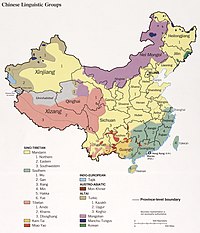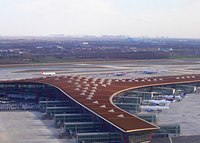Main article: Health in China
See also: Pharmaceutical industry in China
Chart showing the rise of China's Human Development Index from 1970 to 2010
As of 2012, the average life expectancy at birth in China is 75 years,[439] and the infant mortality rate is 12 per thousand.[440] Both have improved significantly since the 1950s.[s] Rates of stunting, a condition caused by malnutrition, have declined from 33.1% in 1990 to 9.9% in 2010.[443] Despite significant improvements in health and the construction of advanced medical facilities, China has several emerging public health problems, such as respiratory illnesses caused by widespread air pollution,[444] hundreds of millions of cigarette smokers,[445] and an increase in obesity among urban youths.[446][447] China's large population and densely populated cities have led to serious disease outbreaks in recent years, such as the 2003 outbreak of SARS, although this has since been largely contained.[448] In 2010, air pollution caused 1.2 million premature deaths in China.[449]
Religion
Main article: Religion in China
Freedom of religion
is guaranteed by China's constitution, although religious organizations
that lack official approval can be subject to state persecution.[232][450] The government of the People's Republic of China is officially atheist. Religious affairs and issues in the country are overseen by the State Administration for Religious Affairs.[451]Over the millennia, Chinese civilization has been influenced by various religious movements. The "three teachings", including Confucianism, Taoism, and Buddhism (Chinese Buddhism), historically have a significant role in shaping Chinese culture,[452][453] Chinese folk religion, which contains elements of the three teachings,[454] consists in allegiance to the shen (神), a character that signifies the "energies of generation", who can be deities of the natural environment or ancestral principles of human groups, concepts of civility, culture heroes, many of whom feature in Chinese mythology and history.[455] Among the most popular folk cults are those of Mazu (goddess of the seas),[456][457] Huangdi (one of the two divine patriarchs of the Chinese race),[456][458] Guandi (god of war and business), Caishen (god of prosperity and richness), Pangu and many others. China is home to many of the world's tallest religious statues, including the tallest of all, the Spring Temple Buddha in Henan.
Clear data on religious affiliation in China is difficult to gather due to varying definitions on "religion" and the unorganized nature of Chinese religious traditions. Scholars note that in China there is no clear boundary between religions, especially Buddhism, Taoism and local folk religious practice.[452] A 2015 poll conducted by Gallup International found that 61% of Chinese people self-identified as "convinced atheist".[459] According to one study from 2012, about 90% of the Chinese population are either nonreligious or practice some form of Chinese folk religions, Taoism and Confucianism.[460] Approximately 6% are Buddhists, 2% are Christians, and 1% are Muslims.[460] In addition to Han people's local religious practices, there are also various ethnic minority groups in China who maintain their traditional autochthone religions. Various sects of indigenous origin comprise 2—3% of the population, while Confucianism as a religious self-designation is popular among intellectuals. Significant faiths specifically connected to certain ethnic groups include Tibetan Buddhism and the Islamic religion of the Hui and Uyghur peoples.
Temple of the White Sulde of Genghis Khan in the town of Uxin in Inner Mongolia, in the Mu Us Desert. Religion in Inner Mongolia blends Chinese and Mongolian folk religious traditions.
Xuanyuan Temple in Huangling, Yan'an, Shaanxi, dedicated to the worship of the Yellow Emperor (said to be the ancestor of all Chinese) at the ideal sacred centre of China.[t]
Temple of Guandi in Chaoyang, Liaoning. Religion in Northeast China is characterised by the interaction of folk religions of Chinese and Manchus (Manchu folk religion). Confucian religious movements like Shanrendao are widespread.
Taoists of the Zhengyi order bowing during a rite at the White Cloud Temple of Shanghai. Taoism is a set of orders of philosophy and rite that operate as frameworks of Chinese religion, alongside vernacular ritual traditions.
Larung Gar Academy of Tibetan Buddhism in Sêrtar, Garzê, Sichuan. Founded in the 1980s, it is now the largest monastic institution in the world, with about 40,000 members of which 1/10 Han Chinese.
The City of the Eight Symbols in Qi, Hebi, is the headquarters of the Weixinist Church in Henan. Weixinism is a 21st-century renewal movement of Chinese religion and philosophy.
Culture
Main articles: Chinese culture and Culture of the People's Republic of China
The Temple of Heaven, a center of heaven worship and an UNESCO World Heritage site, symbolizes the Interactions Between Heaven and Mankind.[462]
The first leaders of the People's Republic of China were born into the traditional imperial order, but were influenced by the May Fourth Movement and reformist ideals. They sought to change some traditional aspects of Chinese culture, such as rural land tenure, sexism, and the Confucian system of education, while preserving others, such as the family structure and culture of obedience to the state. Some observers see the period following the establishment of the PRC in 1949 as a continuation of traditional Chinese dynastic history, while others claim that the Communist Party's rule has damaged the foundations of Chinese culture, especially through political movements such as the Cultural Revolution of the 1960s, where many aspects of traditional culture were destroyed, having been denounced as "regressive and harmful" or "vestiges of feudalism". Many important aspects of traditional Chinese morals and culture, such as Confucianism, art, literature, and performing arts like Peking opera,[465] were altered to conform to government policies and propaganda at the time. Access to foreign media remains heavily restricted.[466]
Today, the Chinese government has accepted numerous elements of traditional Chinese culture as being integral to Chinese society. With the rise of Chinese nationalism and the end of the Cultural Revolution, various forms of traditional Chinese art, literature, music, film, fashion and architecture have seen a vigorous revival,[467][468] and folk and variety art in particular have sparked interest nationally and even worldwide.[469] China is now the third-most-visited country in the world,[470] with 55.7 million inbound international visitors in 2010.[471] It also experiences an enormous volume of domestic tourism; an estimated 740 million Chinese holidaymakers travelled within the country in October 2012 alone.[472]

























